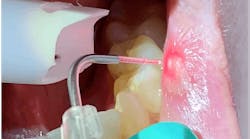This issue will discuss minimally invasive dentistry and remineralizing agents, but not fluoride in great detail.
Minimally invasive dentistry has been around for a few decades, and scientific developments in cariology, dental materials and diagnostic systems have changed our approach to diagnosis and management of dental caries. Dental adhesives and restorative materials, a new understanding of the caries process and remineralization, and changes in caries prevelance have started the change in caries management from G.V. Black’s “extension for prevention” to “minimally invasive.” We now have the scientific basis for early diagnosis; a modified classification of caries based on site and size of lesion remineralization; reduction of cariogenic bacteria; and minimally invasive cavity preparation design, techniques, and material selection. (1) www.dentistinyork.co.uk/pdf/Minimally%20invasive%20dentistry.pdf
The “minimally invasive” method of treating dental caries incorporates the dental science of detecting, diagnosing, intercepting, and treating dental caries on a microscopic level. It also distinguishes between dental caries and dental decay. Dental caries is an infectious disease, and the primary focus should therefore be on control of the infection, plaque control, and reduced carbohydrate intake. (2)
The statements are based on three principles: Modification of the oral flora; patient education; and remineralization of non-cavitated lesions of the enamel and dentin. We must remember that dental caries is an infectious disease and a process, and the primary focus should be control of the infection, plaque control, and reduced carbohydrate intake. The etiology of dental caries should be explained to the patient, together with the means of prevention through dietary and oral hygiene measures.
Remineralization of non-cavitated lesions of enamel and dentin will save the drill and fill routine. Saliva plays a critical role in the remineralization, making is necessasty to assess the quantity and quality of a patient’s saliva. There is strong evidence that "white spot" lesions of enamel and non-cavitated lesions of dentin can be arrested or reversed. These lesions should therefore be managed initially by remineralization techniques. (3)
We know the fluoride is a proven remineralizing agent; however, recommendations for fluoride use by patients at different levels of caries risk are largely based on the saying that “more is better.” (4) There are a number of methods and products that have been studied to enhance the natural repair process by calcium and phosphate in saliva and plaque fluid. These include: combining remineralizing agents with fluoride to enhance fluoride's effectiveness; combining remineralizing agents with a lower dosage of fluoride to decrease the possibility of dental fluorosis in young children without losing effectiveness; and the use of remineralizing materials as independent agents with fluoride use in the background. Delivery methods for remineralization materials include toothpastes, mouthrinses, gels, pastes, chewing gums, lozenges, and foods and beverages.
This issue will look at the products Amorphous calcium phosphate (ACP), NovaMin, tri-calcium phosphate (TCP), and Recaldent (CPP-ACP), (Casein Phosphopeptite/ Amorphous Calcium Phosphate). Future issues will discuss other agents and techniques used in MID.
References
1. Murdoch-Kinch CA and McLean ME. Minimally invasive dentistry. JADA, Vol. 134, January 2003, pp. 87-95.
2. FDI POLICY STATEMENT. Minimal Intervention in the Management of Dental Caries. Adopted by the FDI General Assembly: 1 October 2002 – Vienna, Austria. www.fdiworldental.org/sites/default/files/statements/English/Minimal-intervention-in-the-management-of-dental-caries-2002.pdf
3. Tyas MJ Anusavice K J, Frencken J E, Mount G J. Minimal Intervention Dentistry - A Review. FDI Commission Project 1-97. Int Dent J 2000; 50: 1-12.
4. Zero DT. Dentifrices, mouthwashes, and remineralization/caries arrestment strategies. Proceeds from a Workshop. BMC Oral Health. 2006; 6(Suppl 1): S9.
5. www.ncbi.nlm.nih.gov/pmc/articles/PMC2147065/
Other readings
Minimal Intervention Dentistry
www.dentistryiq.com/index/display/article-display/301967/articles/woman-dentist-journal/volume-5/issue-4/you-and-your-practice/minimal-intervention-dentistry.html
World Congress of Minimally Invasive Dentistry: “Minimally Invasive Dentistry is respecting the health, function and aesthetics of oral tissue by preventing disease from occurring or intercepting its progress with minimal tissue loss.”
www.wcmidentistry.com/
Sincerely,
Maria Perno Goldie, RDH, MS
Editorial Director, RDH eVillage FOCUS





